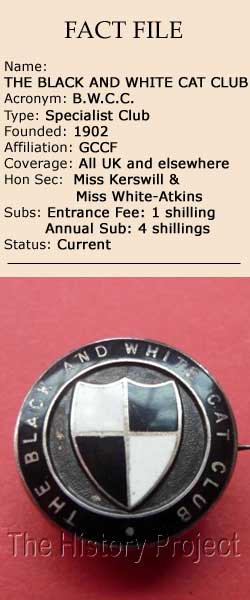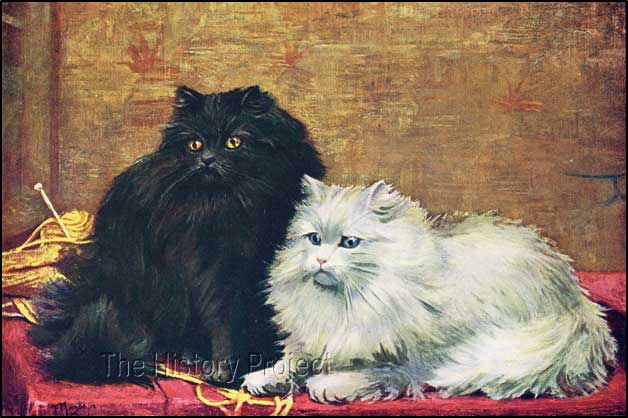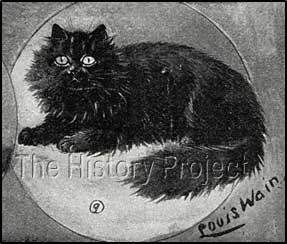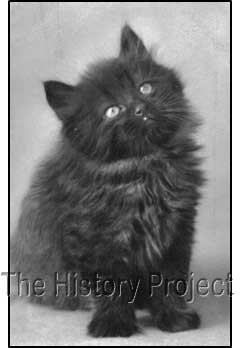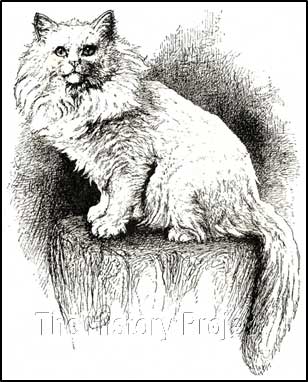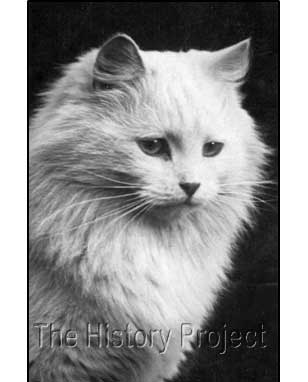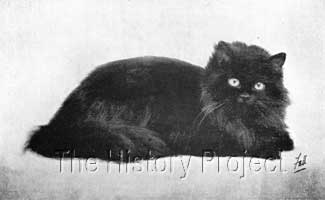 | ||||||||||||||||||||









|
THE BLACK AND WHITE CAT CLUB (1902)
HISTORICAL BACKGROUND:The years 1900 and 1901, were notable for the array of Specialist Societies that sprang up across the British Cat Fancy, as the 'fever' of Cat Shows took on new meaning. The Crystal Palace, Botanic, Westminster and regional shows were all exceptionally well attended and the number of breeders specializing in a particular breed or colour, or group of colours, was duly increasing exponentially. In her introduction to Chapter IX of the 'Book of the Cat' (1903), Frances Simpson alludes to the creation of a specialist club for the Black and White Persian varieties: "The entries in the black classes at our shows are almost invariably the smallest; but as a specialist club for black and white Persians has been started, it is hoped more encouragement will be given to the breeders of these handsome self-coloured cats. 1 Later in the same chapter she reminds herself of the blacks of the past: "In looking back to the old catalogues of Crystal Palace shows, I find the same scarcity of blacks exhibited as at the present day. In 1886 the black male class is marked 'no entry', and in 1889 Mrs H.Warner (now the Hon. Mrs.McLaren Morrison) makes the sole and only entry of 'Imp' in the black class. It was in the following year however, that this same well-known lady fancier exhibited 'Satan,' a black that was never beaten whilst it lived. It was the most remarkable of unapproachable excellence I can remember - a veritable triton among minnows. "In many of the accounts of our largest shows, I remark such paragraphs as these: 'Good blacks with orange eyes were conspicuous by their absence' or again; 'The black classes, as usual, were poorly filled.' It is, therefore, high time that this beautiful breed should receive more attention at the hands of fanciers, and that not only beginners, but those who are well known in the cat world should take up blacks, and, as the expression goes, 'run them for all they are worth'." In the introduction to Chapter X, she says the following about Whites: "A great change has taken place of late years in the quantity and quality of these beautiful cats, for whereas formerly blue eyes were considered quite a rarity, now it is seldom that we see any yellow-eyed white cats exhibited at our principal shows. The most perfect type of white Persian is assuredly to be found amongst the imported cats; there is a certain beauty of form and silkiness of fur which is not possessed by the specimens bred in this country. They are also generally distinguished by unusually long coats, round heads, tiny ears, and wonderful toes tufts.1" What is singularly obvious from these comments is that much more care and observation was being taken in all colours, and in the case of whites, eye colour, and how to produce it or improve it was an important factor, as was length and quality of coat. With the improvement in head and body type in blues, the breeders of blacks and of whites looked to reproduce the same qualities in these primary colours as well. The new Specialist club was formally established in 1902, with the Honorary Secretaries being Miss Kerswill and Miss White Atkins. The fees were set at five shillings, being an entrance fee of one shilling, with an Annual Subscription of four shillings. For many years the Hon. Mrs. Clive Behrens was the club's President and benefactress. After the First World War, Mr. Cyril Yeates (later Chairman of the GCCF),became the Honorary Secretary, and Mrs. B.H.Soame, the Honorary Treasurer.6
SPECIALIZATION:Seeking these refinements in a specific colour, required a larger gene pool, but with a greater emphasis on a limited number of dominating factors. Because of this, breeders who may have originally bred a number of colours, started to specialize in just one or two colours, concentrating their efforts on producing a sound exhibit of quality, one that could be relied upon to reproduce itself with consistency while strengthening those particular traits in their line. In blacks, during this period, Dr Roper and Mr Robert Little both dominated the scene, with some inroads being made by Miss Lenty Collins, Mrs Crowther and Miss Kirkpatrick. A far greater number of breeders however, specialized in Whites, despite the difficulties experienced in keeping the coats clean and free from staining. Notables included Mirs Finnie Young and Miss Hunt, Mrs McLaren Morrison, Mrs Pettit, Mrs D.Champion, Mrs Westlake, Mrs Nott, Miss White Atkins and Miss Kerswill, and the former Miss Willoughby, now Lady Decies. Like most of the early specialist clubs, the main aim of these clubs was not to run specialist shows, but to fundraise and use that money to support prizes and awards in the form of Specials for all the existing shows. This was seen as offering encouragement to breeders, to produce the very best examples of these colour varieties within the Persian breed, and to also exhibit them. Thus the intention was to increase both the number of entries at the Shows and their status of these colours among breeders and fanciers alike. PHOTOS & ILLUSTRATIONS:
THE CLUB TODAY:The Black and White Cat Club is still operating today, making it one of the oldest Specialist Clubs in the United Kingdom. It now also caters for Black or White British Shorthairs, as well as the traditional Black or White Persian. The club holds a Championship Show every year in April, in the town of Cricklade, near Swindon, in Wiltshire. The Patron (2014) is currently listed Mr. E.Wickham-Ruffle.5 REFERENCES:
Registers associated with this article include The Incorporated Cat Fanciers Association of Great Britain (TICFAGB), National Cat Club (NCC), The Cat Club (CCR), Beresford Cat Club (BCC), Feline Federation Francaise (FFF), Siamese Cat Registry (SCR), US Register & Studbook for Cats (USR)including Supplement(USRS), The Studbook of the American Cat Association (ACA), and the Studbook & Register of the Cat Fanciers' Association (CFA).
|
|||||||||||||||||||
Home | Cats | Gallery | Clubs | People | Artifacts | Articles | Updates | Contact Us ©The CFA Foundation, Inc and The Harrison Weir Collection
|
||||||||||||||||||||
